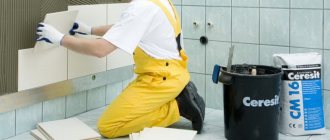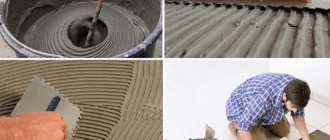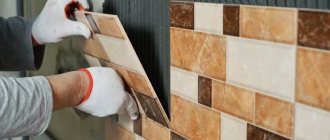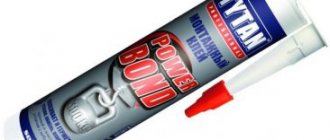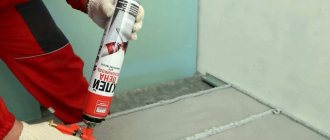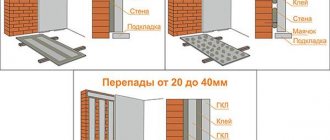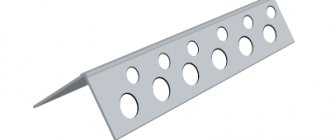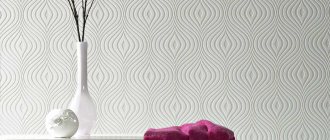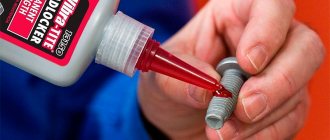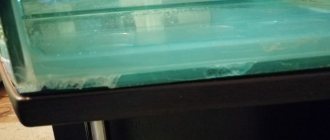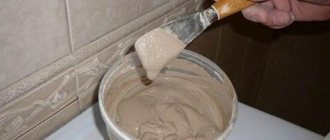The quality of any repair is determined, first of all, by the selected materials. But in order for repairs to not require immediate replacement, they still need to be installed correctly. And the most important element of masonry is the choice of a suitable solution. The adequacy of which depends on many factors. Therefore, there is a need to consider the types of tile adhesives, methods of their use, the relevance of their use in certain conditions and methods of their application. In general, if a person needs to choose a tile adhesive, then he has come to the right place!
Manufacturers now offer a variety of adhesive compositions for different types of tiles, which makes it very difficult to choose.
Important! Tile adhesive comes in different forms and each type must be used for its intended purpose. Otherwise, a person runs the risk of either having to redo the renovation in a short time or wasting money.
Advantages of tile adhesive
- Flexibility in use: tile adhesive is available in a large number of composition variations, allowing you to solve a wide variety of problems. There are floor adhesives that are waterproof, heat-resistant, frost-resistant, leveling, thin-layer, thick-layer and universal. And each of them helps to solve different problems most effectively.
- Durability: the right adhesive for any ceramic tile allows you to make repairs “once and for all.” Because different types of glue exist in order to neutralize the influence of external factors. For example, heat-resistant adhesive reacts normally to high temperatures, so it can be used in oven linings. And frost-resistant glue behaves well under conditions of temperature changes, which is why it is used when cladding facades.
- Ease of use: modern solutions for laying tiles of the correct consistency allow you to adjust the position of the facing material within 20–40 minutes after application. Moreover, they can be applied with different layer thicknesses, so they can even compensate for unevenness of the facing surface.
Before purchasing, it is important to study the properties and advantages of all types of glue, and then you will not make a mistake in your choice.
Special formulations
There are many building structures that have special operating modes. This is mainly due to high temperature and humidity: stoves, fireplaces, swimming pools, sauna rooms, steam rooms, etc. In addition, many finishing materials require special aesthetic characteristics of adhesive mixtures.
Heat-resistant compounds
Heat-resistant or fire-resistant tile adhesive is made from Portland cement, quartz sand and fireclay clay. To increase adhesion, elasticity and water resistance, polymer modifiers are added to it. You should be especially careful when using it, since many brands of heat-resistant glue have a special application technology. For example, “Ivsil Termix” contains a high content of silicates, and special aluminate cement is used as an adhesive. A special feature of its use is the application of the adhesive mixture to the surface of the base 10-15 minutes before the start of facing work. For most other compositions, such a pause in the open time of use is critical, after which the composition applied to the surface becomes unsuitable for further use.
Example: IVSIL TERMIX, heat-resistant Terra, heat-resistant Hercules, Profix RHZUA 895.
Heat-resistant adhesives
Video: tile adhesive - comparison of manufacturers
Moisture-repellent mixtures
Water-repellent tile adhesive is used for lining swimming pools, showers, washing rooms, steam rooms, etc. In addition to water resistance, such compositions must have:
- high adhesive properties;
- elasticity;
- resistance to aggressive chemicals. In particular, to chlorine and mineral salts dissolved in water;
- hygiene, antiseptic properties and resistance to algae, fungus and other types of biological corrosion;
- resistance to mechanical loads - pressure;
- resistance to temperature changes.
In practice, you rarely come across mixtures specifically for swimming pools. As a rule, these are reactive adhesives based on epoxy and polyurethane resins, marked “R”. Most often, high moisture resistance is one of the characteristics of highly elastic, universal adhesives. For example, Ceresit SM 17/ SM-117, Siltek T-81.
In most cases, the moisture-repellent tile adhesive used to finish swimming pools is white, since mosaics are often used as cladding
White tile adhesive
Many types of facing materials made from natural stone ceramics (marble) are available in light colors or even white. Recently, glass or translucent mosaic cladding has become quite popular. For laying such specific materials, white tile adhesive is used. It consists of white Portland cement, white sand and various polymer modifiers, due to which the required performance characteristics are achieved. The cost of such glue is quite high, but there is practically no alternative to it.
Example: IVSIL MOSAIK, LITOKOL LITOPLUS K55, UNIS BELFIX 25kg, Bergauf Mosaik, Ceresit SM 115, LITOKOL LITOSTONE.
Laying glass mosaics with white tile adhesive
Main requirements for adhesive for floor tiles
Spreadability is the main requirement for a mixture for floor tiles. Because good spreadability allows you to fill the entire void area between the tiles and the floor. Due to this, a high degree of adhesion is achieved. And this is the most important thing! Because in this case the floor becomes more resistant to the mechanical stress to which it is constantly exposed.
The purpose of the tile adhesive is determined by the way it is used, as well as its location in the house.
Moisture resistance is an equally important criterion when choosing tile adhesive. Because, as a rule, tiles are installed on the floor in the bathroom. Sometimes the kitchen or hallway is tiled. But these rooms are often exposed to high humidity. Therefore, the floor mixture must be moisture resistant! Therefore, tile adhesive for the bathroom should be one that better withstands high humidity.
Note! The best mixture for flooring materials is epoxy adhesive. Because it meets the criteria listed above.
About the manufacturer
The Prospector company appeared on the Russian market in 1992. Initially, the company specialized in the production of putty. Over time, it was decided that it was necessary to expand the range of products through the production of ready-made building mixtures.
Having adopted relevant European experience, the organization’s specialists quickly managed to establish a full-fledged production cycle for products that are very popular among builders.
The main advantages of the company Prospectors are as follows:
- production of more than 80 types of products to perform various construction tasks;
- fully automated production;
- significant development dynamics, which made it possible to make the brand a market leader;
- introduction of modern technologies into the process of manufacturing goods;
- presence of 15 high-tech production lines;
- Constant checks of product quality at various stages of its production.
The Prospector company has established a process for certifying its own products in the GOST system. Additionally, all types of products constantly undergo appropriate sanitary and epidemiological examination, confirming their full compliance with the requirements of Rospotrebnadzor.
Types of glue by composition
- Cement based
- Epoxy
- Dispersive
Cement based
The simplest and cheapest tile mixture. The composition of which includes 3 components: sand, cement and polymer additives. The qualities of moisture resistance, adhesion and ductility are influenced by all three elements. But it is polymer additives that affect the elasticity of the material.
Cement-based glue is a classic of the genre.
Important! Mortar for cement-based materials must be worked quickly. Because the mixture sets well.
Epoxy adhesive
This mixture is recommended for use on smooth surfaces. The composition includes liquid epoxy resin and catalyst. Which leads to the two main disadvantages of epoxy mortar:
- It is difficult to work with because of the need to strictly maintain proportions when mixing ingredients. For this purpose, you should strictly adhere to the instructions indicated on the packaging by the manufacturer.
- Epoxy mortar may crystallize in the cold. Therefore, its use when cladding the facade of a house is not recommended.
Epoxy adhesive is excellent for installing bathroom tiles and is recommended for installing swimming pools.
Advantages:
- It has a good spreadability, due to which it ensures reliable adhesion of materials. That is, this solution is very plastic.
- Moisture resistant - that’s why epoxy adhesive is often used in bathrooms.
- Does not shrink or crack.
Dispersion glue
Used when working with any surfaces and materials. As a rule, it is used for façade cladding. Because it is able to withstand heavier materials due to its ability to grip materials better. It is very important that the dispersion mixture is sold immediately in finished form. Which is very convenient! But its price is noticeably higher even in comparison with epoxy mortar.
Less expensive than its epoxy-based counterpart.
Separately, it is worth highlighting water-dispersion solutions (polymer) capable of forming a waterproof shell. Due to this, they have a lot of advantages: from environmental friendliness to high moisture resistance and heat resistance. But, firstly, they are expensive, and, secondly, they cannot be used to level the surface. Therefore, they can only be applied to smooth walls or floors.
Which is better to choose?
The answer to the question depends on the priorities: the most budget option, maximum ease of work, special operating conditions of the room, or the need to hide unevenness with the help of foam boards.
Inexpensive construction PVA is rarely used for such situations. The connection will be unreliable, but the finish will have to be maintained for a long time; unevenness of more than 3 mm will not be hidden. The best use is gluing skirting boards and rosettes.
The main advantage of universal water-based polymer adhesives is the optimal balance between cost and quality of connecting seams. They are thick and flexible, resistant to high humidity and temperature changes. Adhesive compositions marked “for interior use” can only be used in dry rooms.
For the purpose of prevention, the walls and ceiling are pre-treated with an antibacterial composition. For putty and plastered walls, a strengthening primer is suitable, for brick and concrete - with an increased ability to penetrate deeply into the soil.
Not the most budget-friendly, but effective option is acrylic putty. It will not only glue the foam and hide unevenness, but will also carefully hide the seams before painting. Sold ready-made, does not shine through the thinnest material, does not shrink, is frost-resistant, and adheres to almost any type of surface.
Eco-friendly acrylic glue is suitable for the living room, bedroom and kitchen. This water-soluble type of liquid nails is used for lightweight foam molds, including porous ones. The best option for rooms with large temperature differences and high humidity is made from synthetic rubber based on organic solvents. The second option dries faster, but it should not contain toluene.
Hot melt adhesive is best suited for gluing small pieces of trim or in areas where the ceiling needs to be heavily cleaned periodically. Working with compound glue is easy, but efficiency is required: maximum adhesion from the first seconds. The compositions are toxic and require the use of protective equipment.
Types of adhesive mixtures by degree of readiness
- Dry
- Liquid
- Ready
Dry mixes
These are cement-based mixtures. The advantage of which is the price and the ability to apply it to uneven surfaces. Therefore, it is possible to lay tiles even if there are differences on the wall. But compared to polyurethane-based mixtures, cement adhesive is less durable and less resistant to high humidity and/or temperature changes.
Ready-made dry glue (mixture) based on cement binder with polymer additives.
Liquid glue
Liquid solution is a ready-made solution that just needs to be mixed. The advantage of this is that there is no need to independently select the ratio of mixed elements. Which is not only convenient and helps save time, but also eliminates the likelihood of messing up. It is important to note that the liquid mixture can be stored in tightly closed containers.
This product can be called universal, as it allows you to work with various materials and substrates.
Important! Liquid mixtures can only be applied to treated surfaces. But they last longer and are more reliable than cement-based mixtures.
Ready solution
Ready-made solutions are dispersion mixtures. And you don’t need to perform any manipulations with them at all. Simply open the can and apply the mixture to the material. Moreover, although such a solution is more expensive, its consumption is significantly lower than in the case of dry or liquid mixtures.
When considering ready-made adhesive for laying tiles on the floor, it is almost impossible to fully know the composition, since this is a manufacturer’s secret.
Important! This type of mixture is used for outdoor work with non-standard materials. For example, when ceramic tiles are placed on wooden, metal or slippery surfaces.
How to calculate consumption
In order to immediately purchase the required number of bags with dry mixture, or buckets with ready-made solution, calculate the total laying area. The average consumption rate is written on each composition; however, this is an average figure, implying work carried out under ideal conditions.
The type of ceramic may affect the consumption; different materials have different degrees of impregnation. The same point applies to the types of base; wood, plaster, concrete differ in their properties, which also affects the consumption of adhesives.
The level of humidity and temperature in the room where the surface will be finished affect the drying speed of the composition; if it happens too quickly, the consumption will increase. The experience of the master can significantly change the consumption; if a non-professional works, then due to the lack of experience, more glue may be needed to create the desired installation.
Taking these factors into account and if you know the area, the easiest way to do the calculations is with an online calculator, which is available on the Internet. Also on the websites of many companies you can calculate the consumption of a specific glue.
In order to immediately purchase the required number of bags with dry mixture, or buckets with ready-made solution, calculate the total laying area.
Classification of glue according to special properties
- Heat resistant
- Frost-resistant
- Fast-hardening
- Leveling
- Elastic and highly elastic
- Thick layer
- Universal
- With reinforced fixation
Heat resistant
This solution is used for lining stoves, fireplaces and heated floors. Must withstand temperatures above 100⁰C. As a rule, long-term heating up to 175⁰C and short-term heating up to 1200⁰C. What makes it possible to lay ceramics on a stove, fireplace or heated floor. In this case, a less heat-resistant solution can be used for lining the chimney.
Heat-resistant tile adhesive is indispensable for lining stoves, fireplaces and heated floors.
Important! It should be written on the packaging that this mixture is intended for use at elevated temperatures.
Frost-resistant
As a rule, it is a dispersion mixture. But frost-resistant tile adhesive must withstand not only low temperatures, but also its sudden changes. Therefore, the manufacturer is required to indicate on the packaging that the glue is frost-resistant. Moreover, there are mixtures that have both frost resistance and heat resistance. Which can be used for lining stoves located in rooms with irregular use.
The properties of frost-resistant adhesive allow it to be used for ideal laying of ceramic tiles.
Important! In rooms that are not used regularly in winter, it is necessary to use glue that has frost-resistant properties.
Fast-hardening
This type of tile adhesive hardens in 3-4 hours. This allows you to quickly start using it. But it is more difficult to work with, since it sets in 5–10 minutes. After which it is no longer possible to install materials. Therefore, it must be placed quickly and accurately.
Quick-drying tile adhesive is a great help for people who want to finish their renovation work quickly.
Leveling
This type of mortar is used when laying tiles on an uneven surface with differences of more than 1cm. Why is it necessary to use cement mixtures? And, naturally, this significantly increases glue consumption. Therefore, such installation will cost more. In view of this, this is rarely justified from the point of view of the cost of the work. But in some cases it is simply necessary.
Leveling adhesive for tiles is a mixture of cement, graded sand and polymers that give it different properties.
Important! The packaging of the leveling solution should say “leveling adhesive”.
Elastic and highly elastic
The elasticity index of a solution determines its ability to sag under mechanical influence. Thus, two classes of elastic adhesives are distinguished: S1 and S2. S1 assumes the possibility of deflection of at least 2.5 mm. S2 - allows the mixture to sag by more than 4.9 mm. Accordingly, S1 is an elastic tile adhesive, and S2 is highly elastic.
Elastic adhesive compositions for laying tiles contain modified additives and plasticizers.
Important! When purchasing a floor mortar, you should pay attention to the elasticity indicator. Because floor tiles are subject to regular mechanical stress. So, buy only those brands that adequately design their products.
Thick layer
The layer thickness indicator refers to cement-based mixtures. Since these solutions are used to correct coating unevenness. Thus, for coating defects of no more than 10 mm, a thin-layer solution is used. When the solution is used not only as a mixture for tiles, but also as a leveler, then a thick-layer mixture is used.
Thick-layer tile adhesive is used for laying large-format floor slabs made of ceramics, porcelain stoneware or artificial stone.
Universal
This type of tile adhesive is suitable for both exterior and interior use. But it should be borne in mind that it may not be very reliable when using ceramics larger than 30X30 cm, as well as when there are temperature changes and high humidity. Therefore, it is better not to put it in the bathroom. And besides, it is not recommended to use it for cladding rooms located in difficult climatic conditions.
For some tile models, universal adhesive may also be suitable. This applies to models 10x10, 20x20, 30x30 cm.
Reinforced adhesive
Mixtures of enhanced fixation include dispersion, polyurethane and epoxy solutions. As a rule, they are used when covering walls with large materials. Since such a solution has increased adhesion properties.
The key feature of reinforced fixation tile adhesive is its increased resistance to static and dynamic loads.
Important! The dispersion solution of enhanced fixation is marked with the sign D2, and polyurethane and epoxy mixtures with the sign R2.
Classification
All adhesive compositions can be divided into several groups depending on the main component from which they are made. Each group of compounds is described in more detail below.
Polyurethane
Features of polyurethane adhesive mixtures are as follows:
- characterized by a high degree of elasticity, capable of gluing any type of surface, even different ones, for example, glass and metal;
- used when necessary to provide additional waterproofing;
- some compositions are capable of expanding after hardening, therefore they are not always suitable for laying fragile ceramic tiles;
- characterized by high strength, elasticity and resistance to sudden changes in temperature.
There are one-component and two-component formulations. A one-component polyurethane adhesive hardens due to exposure to the environment and enters into a chemical reaction with air. Two-component compositions harden due to the combination of components after mixing in a certain ratio.
Cement
This type of glue can be found on sale in dry form in bags. The main composition is Portland cement, sand and modifying additives. Additives in glue are no more than 5%. Due to the sand, the glue is strong and at the same time has a low weight, which ensures a low load on the base.
Depending on the modifiers that are present among the components of the glue, its properties differ:
- when plasticizers are added, the solution becomes viscous and plastic;
- Due to antifreeze additives, a high level of frost resistance is achieved. Such adhesives are used for outdoor work;
- water-retaining additives do not allow moisture to evaporate and give the surface an increased level of strength.
There are two types of adhesive compositions based on cement:
- thin layer. Used in work where tiles are laid on a base with unevenness of no more than 1 cm;
- thick layer. They are used when it is necessary to level out differences of up to 3 cm on the basis, for example, if there is a need to tile the walls, then using cement thick-layer adhesive, you don’t have to do preliminary plastering and leveling the surface.
Important! Be sure to appreciate the level of elevation changes!
Dispersive
They are produced in the form of a paste-like homogeneous mixture, thick in consistency. Mix immediately before application. They can only be used on a flat concrete or plasterboard base that has been previously plastered.
With its help you can lay tiles both on the wall and on the floor. Their composition is an aqueous dispersion based on acrylic, latex or polyvinyl acetate.
Types of glue by application
- For the bathroom
- For pool tiles
- For facade
- For mosaic
- For porcelain tiles
- For clinker tiles
- For laying tiles on plywood
- For gluing tiles to drywall
For bathroom tiles
The adhesive for tiles in the bathroom, first of all, must be moisture resistant. Therefore, such a solution must contain a hydrophobic modifier.
Important! There is a way to save money. In this case, the tiles in the bathroom are laid using a universal mixture, and grouting is done using a moisture-resistant solution.
The adhesive for tiles in the bathroom must have good adhesion to concrete and elasticity, because a heated floor is often used under the tiles.
For pool tiles
According to the international classifier of solutions, the mixture used for tiles in the pool is the same as for the bathroom. But in this case, you won’t be able to save money. You will have to glue everything with a mixture with a hydrophobic modifier.
For facade tiles
When tiling the façade, be sure to use a moisture-resistant, heat-resistant adhesive with good tolerance to temperature changes. That is, you need to use dispersion glue. And since the facade is most often faced with large tiles, it is necessary to use a mixture with an increased adhesion index - D2.
Most often, cement-based dry mixtures are used to attach facade finishing.
For mosaic
The best choice for adhesive work with mosaics is a mixture based on white cement. This is not due to technical characteristics, but to aesthetics. Because gray joints between tiles look unsightly. Not to mention that some materials can absorb the solution and darken.
For porcelain tiles
Porcelain stoneware tiles weigh a lot, so when cladding the façade of a building with this material, it is necessary to use a mixture with a high adhesion index. If porcelain stoneware is used in floor installation, then cement mixtures can also be useful.
Adhesives for porcelain tiles are special compounds that have the properties necessary for the job.
For clinker tiles
Clinker tiles are usually laid on the street or laid on the facade. Therefore, when working with this material, dispersion glue is used. Accordingly, when laying it on the floor, a mixture marked D1 is used, and when facing the facade, D2 is used.
For laying tiles on plywood
Ceramics should be laid exclusively with a dispersion mixture on plywood. Which is due to its coupling performance.
Laying ceramic tiles on plywood is a complex process that requires knowledge in this area.
For gluing tiles to drywall
When working with drywall, it is also recommended to use a dispersion mixture. Since it, in fact, was designed primarily to work with such non-standard materials.
For working with non-standard surfaces
Tile frost-resistant adhesives of this type are used when working with external installation, for example, on a metal base, painted or old surface, or if we are talking about a base that can deform over time, for example, young concrete, OSB wood and other similar materials that they sag over time.
This type of frost-resistant tile adhesive has one difference from the others: it combines with a high level of adhesion and, due to its elasticity, prevents damage to the adhesive joint when displaced.
White
The base of this type of glue is not gray, but white with the presence of synthetic components.
Such mixtures are used to cover outdoor surfaces made of translucent, transparent, and light tiled exterior coatings, and they are also used for working with exterior stained glass windows.
If moisture-resistant components are added to this type of glue, it can be used for finishing work, for example, swimming pools. The white color of tile adhesive is well suited for filling joints between tiles.
Frost-resistant
Ideally, any tile adhesive that is used for exterior work should have a high level of frost-resistant properties and withstand a large number of defrost-freeze cycles.
As a rule, special components are added to such adhesives, which allow the adhesive seam not to deform or fall apart even with fairly sudden changes. This material is well suited for working on concrete, brick and others.
In addition, due to its composition, the glue is economical to use. The layer, if we are talking about small tiles, can be made moderately thin and at the same time it will be durable.
Although when applied to larger external coatings, the consumption will, of course, increase.
How to use tile adhesive correctly
- All standards specified by the manufacturer on the packaging must be strictly observed.
- The mixture should be applied during “open operating hours”. Which for ordinary solutions is 10-20 minutes, and for quick-setting solutions - 5-10 minutes.
- The ideal temperature indoors or outdoors is between 18 and 24⁰C.
- To work with tiles, you should choose the right spatula. Thus, a V-shaped notch trowel is used when laying small tiles. When laying medium-sized ceramics, square teeth are used. And for large tiles, it is recommended to use U-shaped teeth.
- The mixture should be stored in a closed container according to the instructions.
Fungicidal glue is often used in the bathroom. Its main purpose is to protect the surface from mold and mildew, as well as to prevent their spread.
